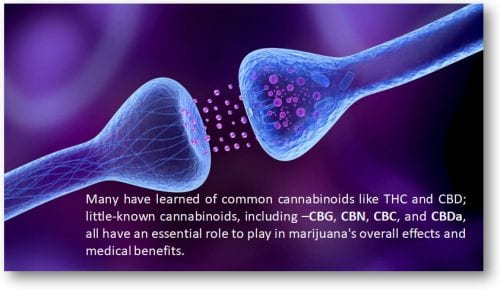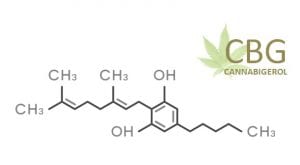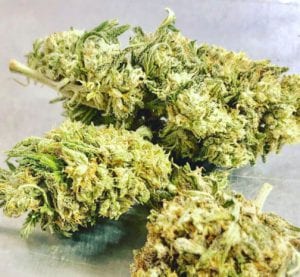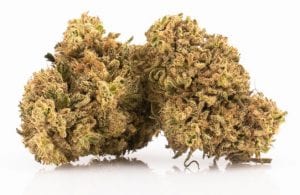This article will present the researches, facts, and working of the most essential cannabinoid nobody talks about, CBG (cannabigerol). It is usually regarded as “the mother of cannabinoids” and plays an essential role in the formation of THC and CBD.
While often ignored, possibly because of its scarcity in the plant itself, CBG is gaining a ton of traction recently as more and more companies are starting to focus on its production. And it was about time—In the mid-60s, we came to think about CBG, but most of the research on it has just taken place during the last decade.

Continue reading to find out what’s the deal with CBG, its possible benefits, and how it can be advantageous.
What is Cannabinoid?
Contents
Like all plants, hemp (Cannabis Sativa) includes compounds that make up a plant’s compound structure. Cannabinoids are a kind of chemical compounds in the marijuana that react with the cannabinoid receptors in a human body.
The endocannabinoid system works as a regulatory system. It creates internal balance and concordance. This extensive system comprises of receptors that are attentive to get chemical signals from endocannabinoids and phytocannabinoids.
When the hemp cannabinoids enter the body, they either connect or stimulate with these receptors to produce more of their own cannabinoids. It assists in restoring balance and improve overall wellbeing.
What is CBG in Cannabis?
Cannabigerol is one of the natural cannabinoids found in the cannabis plant. It is a minor cannabinoid, as a harvested plant will generally contain up to 1% CBG (or up to 2% maximum). But how does CBG become? The cannabis plant creates CBGA—the “A” stands for acid, meaning that CBGA is the acidic form of cannabigerol. Cannabigerol acid is the headliner of the article here, as it is a precursor to the three main cannabinoids, THC, CBD, and CBC. Without CBGA, we wouldn’t have CBD or THC. During the plant’s lifetime, common enzymes (called synthases) transform CBGA into THCA, CBDA, and CBCA. It then transforms into THC, CBD, and CBC through decarboxylation, the evacuation of a carboxyl group with heat. The tiny volumes of CBGA that remain on the plant after the other cannabinoids are decarboxylated and transformed into CBG.
Cannabigerol is what we describe a ‘parent cannabinoid,’ from which other cannabinoids are formed, including – CBD and THC. During hemp’s growing process, numerous chemical changes result in different cannabinoid production. In the numerous stages of the plant’s growth cycle, the plant’s chemical structure transform. In the early budding stages, what starts as the acidic origin compound CBGa – transforms into other compounds, such as, THCa (THC with acid) and CBDa (CBD with acid). Further along, the cultivation process, when a hemp plant gets warmth or ultraviolet light, either artificially or through regular sunlight. A process called decarboxylation occurs. It appears in the acidic parent CBDa and THCa, transforming again into the dominant cannabinoids CBD and THC. Nature designs this cannabinoid network, at varying levels to empower synergy within the plant and gives it its remarkable benefits. While each cannabinoid has its effects, cannabinoids often work better together in what’s known as the entourage effect. Cannabigerol is one of the numerous other cannabinoids that work as a component of an extensive system. As all cannabinoids work to support one another, nobody cannabinoid can be said to be less important than the other. The cannabinoid structure found in hemp is nature’s way of creating excellent chemistry. We are still yet to find the full cannabinoid effects in the body. However, research has shown hope in CBG and other CBG cannabinoid combinations.
What’s relevant here is that almost all CBGA converts into THCA and CBDA right off the bat in the process. It means that the measure of CBGA left for the development of CBG is extremely low, which is also the cause of the low yields. Contrasted to THC and CBD, CBG yields are usually ten or even 20 times lower. Thus, a single direction to obtain a CBG rich extract is to harvest the plant a lot earlier, and before CBGA forms, the acidic precursors of CBD and THC. In this case, we need to sacrifice THC and CBD to increase the concentration of CBG. Another way to raise the CBG yield is to crossbreed plants and streamline them for CBG composition, which is a complicated and probably risky method, notably acknowledging the low demand for CBG products available right at this point.
Similar to cannabidiol (CBD), cannabigerol (CBG) is also a cannabinoid. The two composites are available in marijuana plants. Both are also non-intoxicating, indicating they won’t get you high. So what’s the distinction between CBD and CBG? CBG is the precursor for other cannabinoids. When warmed, CBG-A, the acidic form of CBG, breaks down. It doesn’t just form CBG; it also forms THC (tetrahydrocannabinol), CBD (cannabidiol), and CBC (cannabichromene). While there is much research available on CBD, research on CBG is limited. We nevertheless expertise the two interact differently in the body. CBD has a moderately low affinity for cannabinoid receptors and interacts mostly with the endocannabinoid system. On an indirect basis, CBG interacts straightforwardly with the brain’s CB1 and CB2 cannabinoid receptors.
As such, early research suggests that the compound might be useful in treating different conditions. According to a 2013 study on mice, the compound may reduce inflammation associated with the inflammatory gut disease. Another study in 2014 found that it might have the option to reduce growth rates of malignant growth cells and other tumors in rats with colon disease. In the interim, other research has discovered that the substance may also be beneficial in managing glaucoma, Huntington’s Disease, bladder dysfunctions, and bacterial infections. Despite its healing potential, the challenge in producing a substantial quantity of the substance has both hindered further analysis into it and its commercialization. Although a promising compound, because of limited research on its long-term effects and how it interacts with other medications, experts suggest alert when using the product until further research is available. We need thousands of pounds of biomass to produce small amounts of CBG isolate,” writes James Rowland, CEO of Steve’s Goods, CBG products company from Colorado. That is because most hemp just contains tiny percentages of CBG, whereas presently hemp strains contain 20 percent CBD in the harvest. If the CBG content of the same yield is just 1 percent, you have to extract 20 times the measure of biomass to get the same measure of CBG out.
All of this has yet to come in clinical trials, but some early studies show that CBG might be a promising treatment for several conditions. Remember, this isn’t definitive proof, and while some studies show promise, the assertations are “unwarranted as of now,” says Dr. Solomon. “CBG is also demonstrated in laboratory studies to restrain certain cancerous cells’ growth,” says Dr. Goldstein. A review article in 2009 showed CBG could probably slow tumor growth. Another study from 2016 stated that the preclinical information strongly supports the notion that non-psychoactive plant-inferred CBS (cannabinoids with CBG) can act as primary inhibitors of tumor progression well as improve the first-line treatments. A 2014 study provided similar results, stating that CBG repressed tumor growth in colon cancer, and 2006 study, including cannabigerol, remarked it might help for breast cancer. In 2016, a study revealed that it could be an appetite stimulant in rats, which could encourage patients of chemotherapy. It could be a massive deal because CBD alone does not help with glaucoma, but THC does-so for patients who need to treat glaucoma using cannabis. It might be a method to do so without the intoxication outcome. A 1990 study checked the usage of CBG for glaucoma and asserted that cannabigerol and associated cannabinoids might have the healing potential for glaucoma. Nevertheless, you should continue your doctor’s prescription for glaucoma and use CBG or cannabis as an extension to your Rx meds after discussing it with your doctor. Scientists studied rats in 2013 for the analysis of CBG for colitis. In that research, the results were assertive, stating that CBG reduced the effect of colitis. According to the study, IBD patients have experienced “successful management of abdominal pain, joint pain, cramping, looseness of the bowels, poor appetite, weight loss, and nausea” with the use of cannabis. Still, there are not numerous studies just yet exploring CBG as an isolated compound. CBG also exhibits great hope as an appetite booster, as scientists found in a 2016 study on CBG for appetite. The scientists gave rats either CBG or placebo and saw their feeding practices. The rats that ingested CBG expanded their number of meals and doubled their food intake. However, the quantity of food and the extent of meals were unchanged. The researchers didn’t observe any adverse effects in rats treated with CBG. It might make this cannabinoid a promising therapy for conditions such as anorexia and cachexia. A 2015 study on mice discovered that the CBG, or its mixture with other phytocannabinoids, could treat neurodegenerative diseases. One such disease that we know is Huntington’s disease. “CBG normalized representation of abnormal genes associated with brain degeneration, pointing that it’s a neuroprotective compound,” remarks Dr. Goldstein. MRSA (Methicillin-resistant Staphylococcus Aureus) is a staph infection resistant to methicillin (a normal anti-infection), rendering threatening or even deadly bacterial infection. According to research in 2008, CBG showed promise for treating MRSA as an antibacterial agent. Dr. Solomon said this is a region where CBG shows genuine hope. It might help with MRSA. Besides, CBG has the potential to handle bacteria that are immune to traditional antibiotics. One research in 2015 on cannabinoids for bladder dysfunction discovered that they could lessen acetylcholine-induced bladder reductions in mice. With all of the cannabinoids examined, CBG was one of the most efficient, along with THCV (Δ9-tetrahydrocannabivarin). CBG can also diminish these contractions in humans. CBG inhibits GABA uptake, which could prompt muscle relaxation, tension relief, and sensation of peace in the body and brain. This research is available from Bonni Goldstein, M.D., a physician with exceptional experience in pediatrics and is currently a specialist in cannabis medicine, as noted in a video given below. A 1975 study corroborated this. Pharmacologically, GABA uptake inhibitors are already beneficial to treat anxiety. Because of this reduced “GABA uptake,” CBG could decrease anxiety. A 2007 study examined CBG’s capacity to manage eczema and psoriasis, and as stated, it may further limit the inflammation caused by IBD. As referenced, if you’re consuming cannabis in its aggregate (whether that is smoked, delivered in a tincture, or eaten), you’ll be getting a bit of CBG in its standard form. So far, there haven’t been statements of adverse side-effects to CBG all alone, but there’s not almost enough analysis on it yet. Therefore, (as always!) talk with your doctor before combining any prescription or supplement-OTC.
No, CBG won’t get you high. Like CBD, cannabigerol is somewhat psychoactive but not psychotropic. CBG and CBD influence the brain very differently to THC, and they do not accompany intoxicating effects. CBG may induce relaxation and euphoria in high concentrations, but most of the effects this cannabinoid has on your system are not psychological. We have previously explained why CBD won’t make you fail a drug test. The same rules apply to CBG. CBG isolate, and expansive spectrum oil that contains CBG are generally safe to consume before a drug test. If your CBG oil contains THC, then there is a risk of a failed drug test, depending on the assay’s sensitivity and THC content.
If you’ve tried a whole plant CBD oil, then you’ve probably taken CBG. We can derive full-spectrum extracts from the hemp plant to make CBD products. The extraction process that protects a full spectrum of cannabinoids maintains as a significant part of the plant’s substance composition. CBG is present in tiny amounts in develop hemp plants. Most generally, CBG levels are at their highest before the hemp growth cycle. When the plant is suitable for harvesting, CBG levels become lower. However, this doesn’t imply that all CBG is lost. High-quality entire plant hemp extracts often contain a comprehensive profile of cannabinoids, including CBG. To know the correct CBG content in your CBD products, you can review the product reports to see how much CBG it carries.
CBG (similar to CBD) is available in hemp plants and binds to similar receptors in our bodies. Explore the life-changing benefits of CBG oil, powder, tinctures, and such other products. Below are some of the best CBG products available today.
Jack Frost CBG flower contains 18.8% total cannabinoids, including 17.7% CBG. It has frosty, white, and silver trichomes that coat the buds. These buds have a citrusy and hoppy aroma with hints of chamomile and pine that reminds you of fresh mountain air. CBG stands for cannabigerolic acid, which converts into tetrahydrocannabinolic acid (THCA), the precursor of tetrahydrocannabinol (THC), and cannabidiolic acid (CBDA). Besides, CBG is the parent molecule of THC and CBD. Moreover, CBD and CBG are non-psychoactive. It offers a unique smoking experience. Each cannabinoid has its beneficial properties, many that overlap, but when you take CBD and CBG together, it creates a unique and satisfying smoke. Jack Frost is under 0.3% THC delta-nine following Farm Bill sec. 7606 of The Agricultural Act of 2014. White CBG delivers an enlivened calm that is noticeably different from a CBD flower. An exceptional alternative for anyone seeking for a near-zero THC strain in hemp flower! These big beautiful CBG buds are frosted and dense and have a subtle and unique flavor profile. The nose is understated as you’d expect from a CBG flower, but noticeable notes of sweet butter and warm earth serve up an inviting first impression. It is a cross-breed of Columbian, Mexican, and Thailand strains, Destroyer is a pure Sativa cannabis that is unique on its own. Moreover, It carries only 10-15% THC. Seasoned marijuana lovers cherish their potency and effects regularly. Moreover, you don’t have to worry about becoming too high as the psychoactive effects are thin enough that you can still work and think sharply. The Super Glue (CBG) has an old-school musky, aromatically rich piney scent. The buds are of medium to light density and have a beautiful sandy green hue with dark orange terpenes. The Super Glue buds have been well manicured via hand trimming. The smoke is smooth, providing a unique, mouth-numbing taste. The effects are the real feature of this strain boasting over 22% CBG. If you like CBG, you’re going to love the Super Glue (CBG). The smell is piney, musky, and earthy. It’s pleasantly aromatic and springs out of the jar once you open the lid. There is no spiciness to it at all. Very subtle yet rich. It is an excellent alternative for anyone new to cannabis. The strain holds high CBG content. Besides, It is particularly beneficial if you favor less THC than some other weed and want more impressions of CBG. Furthermore, you will get faster effects by inhaling the bud. The after-smoke effect of this strain is very potent, which can make you stoned. Apart from that, it’s effective therapeutically for pain relief and insomnia. Moreover, it has a very fresh, earthy flavor with woody hints. Indica-dominant John Snow is a unique cross of Philly Sour Diesel and Jack the Ripper. Interestingly, the strain holds 21.7% CBG! Non-psychoactive CBG gives strong engagement in killing or slowing bacterial growth, reducing inflammation, repressing cell growth in tumors, and increasing bone growth and density. Partially noted for its frosty flower as it carries high CBG content, John Snow is a potent barrier for many parts in the body. Furthermore, the strain renders a relaxing sidekick after a busy, tiring day. Moreover, the strain provides therapeutic, relaxing, and inspired feelings in users. This Hemp herb is powerful in Cannabigerol (CBG), which we know as the Mother Cannabinoid. With a unique lemon flavor, Lemon Cream is a sensory delight. One of the perks of this CBG strain comprises the addition of various cannabinoids, including CBCa, CBDa, and CBD. The CBG concentration in this strain is 15.284% after its transformation from the acid form — CBGa. The strain incorporates 152.84mg CBGa, 0.154% CBC of the dry weight. Furthermore, CBCa content reaches up to 0.349%, with 3.49mg per gram. Apart from that, it holds 0.068% CBDa and holds up to 0.68mg per gram. Moreover, Lemon Cream has a low concentration of THCa, which is only 0.127% of the flower, with 1.27mg per gram. Therefore, total THC (including Δ9-THC and THCa) is 0.16% of the flower’s weight, far lesser than the 0.3% of the legal limit. Thus, you won’t get in trouble buying this strain. It’s a raw Indica cannabis strain, well-known for its high CBG substance with about 1.3% CBG. This strain also has 20.5% THC content; therefore, you may not notice the CBG effects right on the top. The vital thing about this weed is that you will still get the real advantages of CBG that this strain holds. It will most probably help you with pain relief, depression, nausea, and anxiety. Final Verdict
We understand that CBG acts as a low-affinity antagonist at the CB1 receptor. However, CBG pharmacological activity at the CB2 receptor is at present unknown. We need more research to understand the endocannabinoid system completely. Indeed, CBG is not the most well-known of all the cannabinoids. However, it appears to have a sensational influence over many of the body’s vital systems. There is still more to learn about this cannabinoid and how it affects us. However, the initial research is incredibly promising. With all the benefits you can harvest and the incredibly low risk of side effects, there’s no reason not to strive for CBG products. If you’re seeking medical benefits for one of the diseases listed above, speak with your doctor and local dispensary to get the best CBG product which is right for you. CBG does not produce any side effects when used in therapeutic dosages. The key here is “therapeutic doses,” or you can encounter adverse side effects if you consume exaggeratedly. However, research will assist us with understanding the role that marijuana plays in human health. However, we are getting closer and closer all the time. Ideally, we will soon have a full understanding of how these cannabinoids impact our health and wellbeing. The content in this guide is intended strictly for informational purposes. We do not promote any product or represent that the products mentioned in this article are a treatment for any medical condition. Furthermore, we cannot guarantee that information furnished is error-free or perfect and is not liable for users’ actions. We do not endorse user-reported information, particular strain, product, producer, organization, treatment, or therapy. We do not make representations regarding the use of cannabis and do not provide any of its views on the usage, benefits, or promotions.
How Does CBG Work?
What’s so important in CBG?
CBG vs. CBD — How the Two Cannabinoids Relate?

CBG in Cannabis — Here’s What The Research Says
What Are the (Potential) Benefits of CBG?
Potentially fights cancer
May treat glaucoma
Could help inflammatory disease and colitis
CBG as an appetite stimulant
Relief from neurodegenerative and Huntington’s disease
Reduce MRSA with antibacterial properties
CBG usage for bladder problems
Contributes to GABA reuptake inhibition
Managing inflammation
Will CBG Make You High?
Where Do You Find CBG in Cannabis?
The Best CBG Products From Reputed Brands
8 Best Cannabis Strains Containing High CBG
#1 – Jack Frost from CBD Flower USA

#2 – White CBG from BirkshireCBD

#3 – Destroyer CBG Strain

#4 – Super Glue CBG from Black Tie

#5 – Exodus Cheese CBG

#6 – John Snow from Carolina Hemp Company

#7 – Lemon Cream Diesel CBG from Native Hemp Company

#8 – Williams Wonder

Disclaimer:

